Contents
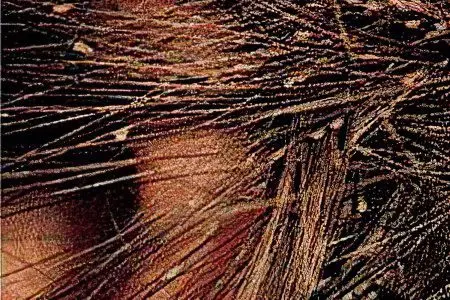
Lice are insects that parasitize the human body. When infected with lice, doctors talk about a disease such as pediculosis.
Lice are ectoparasites of the lice order. With its mouthparts, the louse pierces the skin of the host animal and sucks out its blood. Lice can only live on a few closely related host species. Human lice (Pediculus humanus) are common in all corners of our planet. They carry very dangerous diseases – typhus (typhus and relapsing), Volyn fever, and so on.
A disease in which lice parasitize on human skin is called “pediculosis” (lice). There are three types of lice that can parasitize on humans: head, clothes and pubic louse (ploschitsa). Thanks to this classification, three subspecies of the disease are distinguished, respectively: head lice, body lice and pubic pediculosis. Sometimes these subspecies form a mixed type of pediculosis.
Even in modern society, the problem of lice is still relevant, and they are common. You can get infected from a sick person. Often, outbreaks of the disease are observed in organized groups: in kindergartens and schools. Sometimes people become infected when using bed linen on the train, while going to saunas and baths. Most often, it is the head that is affected. It is noteworthy that lice prefer people who wash their hair regularly: it is easier for parasites to suck blood from clean skin.
What does a louse look like?
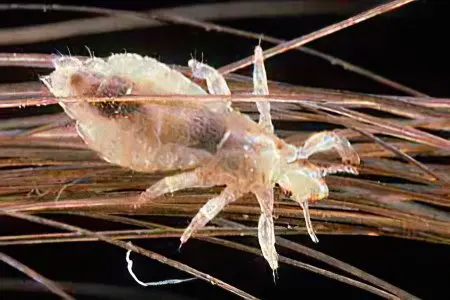
The louse is a small and mobile insect. In just a minute, it is able to cover a distance of 23 cm. It is difficult to notice the parasite.
The color of the lice is gray or whitish. In length, it does not exceed 3 mm. The parasite has 3 pairs of legs.
On the head, it is easier to detect eggs that lice lay. They are called nits. Lice lay them in significant quantities.
Nits are represented by dense yellow sacs. They are well soldered with hair. You can’t just shake them off.
The size of the nits does not exceed 1,5 mm.
Lice and nits most often settle on the scalp. However, sometimes they populate eyelashes and eyebrows.
One insect lives 3 weeks. If it leaves the head, then the life of the louse is reduced to 24 hours. Nits are able to remain viable for 14 days.
Lice feed on human blood. The head after infection begins to itch after about 14-30 days. Itching is explained by the fact that during the piercing of the skin, lice secrete saliva, which leads to irritation.
Causes of head lice
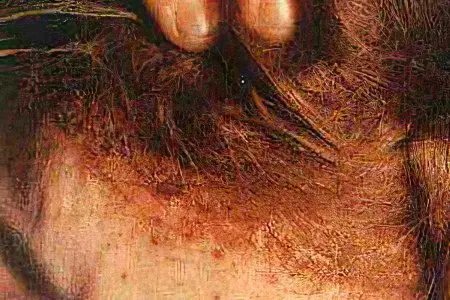
Lice cannot fly or jump.
They are able to get on the head of a person in such ways as:
during direct contact.
While using someone else’s personal hygiene items, such as towels, bedding, combs.
When using a headgear taken from an infected person.
Lice are able to run from one head to another, upon hair contact. The likelihood of infection is especially high if the person’s hair is long.
Many people believe that lice are the lot of asocial groups of the population. In fact, anyone can get infected, regardless of their status. The likelihood of infection increases in places such as: school, kindergarten, summer camp, sauna, bathhouse, swimming pool, hotel, hairdresser, train.
Symptoms of Lice Infestation
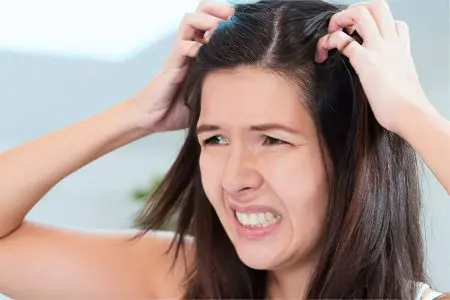
The fact that a person has lice can not be understood immediately. The first symptoms develop after 2-3 weeks. Once on the head of a person, the louse is attached to his hair. It needs blood to reproduce. The insect feeds only on it. To obtain blood, lice pierce the scalp with their proboscis. In the place where the bite was made, a small red spot may remain. These spots start to itch. After the louse is full, it begins to lay eggs. They are called nits. Eggs are securely attached to the hair. They cannot be washed off with regular shampoo. After a few days, new insects hatch from the nits.
If you carefully examine the scalp, you can find yellow crusts on it. Sometimes inflammation of the hair follicles is noticeable. Where there are most lice (on the back of the head, behind the ears, etc.), the skin is red, the rash resembles eczema. If you look closely at the hair, you can see nits. They are white or yellowish in color. If you crush the nits, you can hear a click.
When the disease is not treated for a long time, the hair sticks together, their follicles become very inflamed, they begin to fester. Lice can cause the development of lymphadenitis. At the same time, the lymph nodes, which are located behind the ears and on the neck, increase in size and begin to hurt.
Diagnostics
Diagnosis is reduced to examination of the scalp and hair. The fact that a person is infected with lice will be indicated by nits and scratching on the skin.
Removing lice from the head
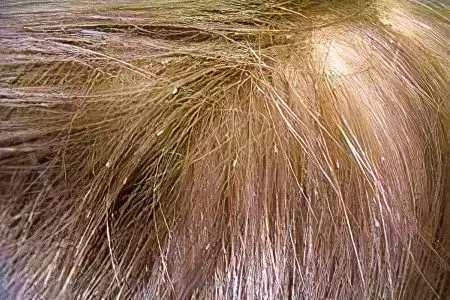
In past years, lice therapy was not effective enough. Insects were poisoned with tar kerosene, Dichlorvos, vinegar, cranberry juice. All these funds are folk, their use is not recommended in modern conditions.
Now in pharmacies you can buy various drugs for the treatment of lice. They come in the form of shampoos or sprays.
Remedies for the treatment of lice:
Flu Marx (450 rubles), Emulsion D-95 (200 rubles). These are safe oils that are odorless, but have sufficient effectiveness.
hellebore water.
Shampoo Pedilin with malathion.
Nittifor, Nix, Medifox concentrate 5%, Medifox-gel, Hygia, Veda 2. All these products contain permethrin.
Foxylon. This lotion contains benzyl benzoate.
Shampoo Paranit with mineral oils.
Pair Plus is a combination drug that contains permethrin, malathion and piperonyl butoxide.
Sulfur ointment with a concentration of 5%.
Boric ointment.
A dermatologist should determine which remedy is suitable for a particular person. Before starting treatment, you must carefully study the instructions for use and strictly follow them. Many drugs are highly toxic, so they should be used with caution. It is forbidden to use these products for the treatment of pregnant women, young children, people with allergies, as well as patients with respiratory diseases.
After the time of action of the drug comes out, you will need to comb your hair with a comb. The teeth should be sparse. To make it easier to comb out nits and lice, you need to treat your hair with olive oil. An iron comb is used for combing.
If lice appeared in a small child, then you can deal with them by combing. It is carried out on the 1st, 5th, 9th and 13th day. Conditioner is applied to the hair first, and then they are carefully combed with a comb.
It is important to consider that either the combing method or medicines are used to get rid of lice.
Some people believe that getting rid of lice can be done by cutting their hair short. In fact, nits are located no further than 5 cm from the surface of the head. So a haircut won’t help.
Until a person is sure that he has got rid of the problem, he is forbidden to visit crowded places. This period is 14 days after the treatment.
The repeated probability of infection is low, since lice do not live longer than a day outside the head.
To minimize the risk of getting lice again, you need to follow recommendations such as:
Do a general cleaning of the room.
Wash bed linen and clothes at 54 degrees. Nits and lice will die after 5 minutes of such treatment.
Treat combs and hairpins with disinfectants. They are placed for an hour in water in which lice shampoo is dissolved, or in an alcohol solution. You can wash the comb with soap and put it in the freezer for 2 days.
Those things that cannot be washed must be dry-cleaned or packed in bags for 2 weeks. During this time, all insects will die.
How to get rid of lice in 1 day and forever?
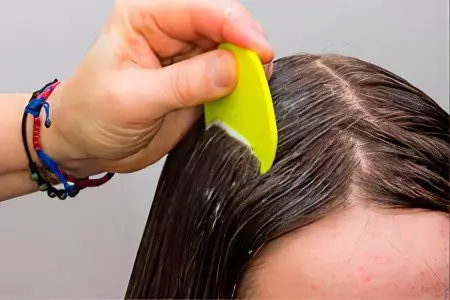
Combing is not inferior in efficiency to treating the head with chemicals. This was proven in an experiment conducted in Belgium.
Preparations allow you to destroy adult insects, but nits often survive. It is tightly soldered to the hair, so re-treatment of the head with toxic substances is required.
Lice infestation prevention
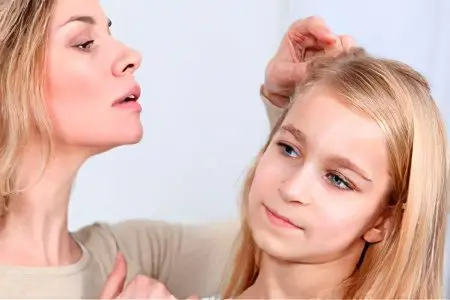
To prevent infection, you must carefully observe the rules of personal hygiene, and also do not use other people’s personal belongings.
Long hair in public transport must be removed under clothing, or collected in a ponytail. Do not use other people’s combs, elastic bands, hairpins, towels. If you have to travel by train, it is recommended to bring bed linen from home. You can not try on other people’s hats.
If lice were found in one family member, then all people who live with the patient in the same territory should undergo treatment.
After treatment, you need to iron all bedding, hats, towels. It is important to inform school and kindergarten about your illness in order to prevent the spread of lice.










Kwaio chawa awareti chaga moto mwirini mana mududu hatari